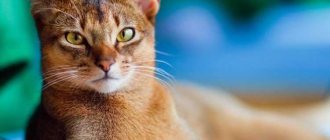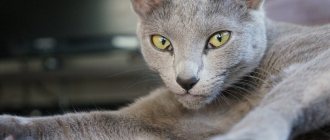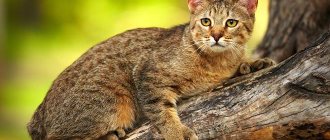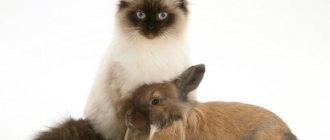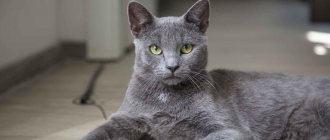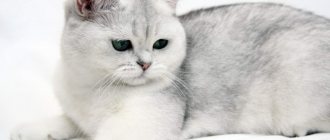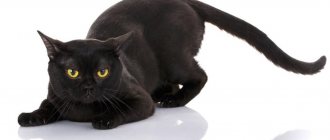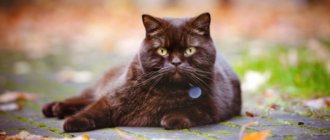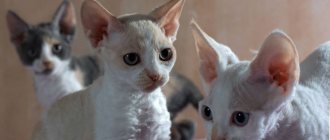A graceful beauty with a thousand-year history will easily find a place in the human heart and enter the very soul. The Abyssinian cat , with its strong, flexible and graceful body, commands respect not only from those who keep it, but also from everyone who watches the animal’s games and its behavior in general. Keeping such a charming animal in your home is a pleasure - caring for Abyssinians is not burdensome, which is also a significant advantage of this breed. The affectionate beauty also doesn’t mind settling in the house of a kind and sociable person - this creature brings real joy to the family!
History of the Abyssinian cat breed
Abyssinian cat
Abyssinian cats have become popular quite a long time ago, but researchers have not been able to find out the exact geographical region and time of origin of the breed. Several main versions have been formulated. The first said that the animals first came to Europe after the war between England and Abyssinia (Ethiopia) in 1868, where they originated from. As the main evidence, supporters of the theory used an English book from the second half of the 19th century with a lithograph of a cat named Zulu, which was acquired by Captain Barrett-Lenard after the end of the military campaign. Despite the external resemblance to modern representatives of the breed, there is no convincing evidence that the cat depicted was actually an Abyssinian.
Other researchers believed that the animals had Egyptian roots, since ancient figurines depicted similar pets. Perhaps they were the ones worshiped by one of the most mysterious civilizations in the world. At the same time, genetic analysis carried out by scientists showed that these cats were always closely related to animals that lived on the coast of the Indian Ocean. In any case, the ancient line of the breed was considered extinct. Modern Abyssinian cats first appeared at shows in Great Britain in 1871, finishing third among 170 other breeds.
A detailed description of these animals was made in 1882, the initial standard was formed by 1889, and official recognition with entry into the stud book awaited the breed only in 1896. In the early 1900s, the first representatives came to America, which ensured the survival of the breed in the future. The Second World War almost completely wiped out Abyssinian cats from the European continent - only about a dozen individuals remained in the UK. It was the American specimens that helped restore the population.
Due to the changes that cats managed to undergo in the USA, after the war it was necessary to recognize the existence of two branches that have survived to this day: American and European. These animals managed to gain worldwide fame, although they remained exotic in the CIS. According to the CFA, Abyssinian cats ranked second in popularity among short-haired breeds in the United States and Europe in 2012.
Appearance of the Abyssinian cat
Abyssinian cat kitten
Abyssinian cats are strong and flexible and have a medium body size. Well-developed muscles and long legs allow animals to jump a distance of 6 times their own length. Males are larger than cats, but sexual demorphism is not as pronounced as in other breeds. Typically the weight is between 3-4.5 kg. Abyssinians have a chiseled silhouette, a harmonious physique, and move incredibly gracefully, which reminds them of miniature pumas. The American line has a more graceful and lighter build than the European line.
Head
Proportional, has a wedge-shaped shape without pronounced flat surfaces or points. The nape line gently merges with the neck. The nose is of medium length, straight, connected to the forehead by a smooth line. The chin is developed, firm, rounded. The muzzle is well defined and matches the soft contours of the head. Adult males may have prominent cheeks. Pinch, a pointed muzzle with a “foxy” expression, are considered unacceptable.
Eyes
The eyes of the Abyssinian cat are large, almond-shaped with a fairly wide set at a slight angle. An oriental or completely circular cut is not acceptable. Sparkling eyes can be any shade from amber to green. They have a black outline regardless of suit. If you have a silver color, a green eye tint is desirable. This zone always has a narrow light halo to match the undercoat. Dark lines in the corners of the eyes visually continue the outline of the upper eyelid.
Ears
Abyssinian cat face
Large, set wide, slightly tilted forward, which gives the cat an alert appearance. The ears are wide at the base, and narrowed and rounded towards the tips. The skin is covered with very short hair with a special bald spot in the center (the so-called “thumb print”). The inside of the ear may have woolen brushes.
Neck
The neck of the Abyssinian cat is graceful and quite long.
Body
Moderately elongated, flexible, with harmonious proportions. The body is medium in size, the muscles are developed, but not coarse. The chest is rounded, the back is slightly arched, but the hips should not be in a low position.
Legs and paws
The legs are strong, long and thin. Oval paws have small, well-pressed toes, which gives the impression that the cat is stretched out on tiptoe.
Abyssinian cat paws
Tail
The tail of the Abyssinian cat is thin, long, and narrows towards the end.
Wool
The cover is short and elastic, with a magnificent shine and characteristic ticking. The silky coat is thick and soft, with little undercoat, and lies close to the body. The cover is longer along the back, but this is almost imperceptible.
Color
Abyssinian blue cat
An important feature of the breed is its warm, rich color with an unusual iridescence and without a pattern. This is possible thanks to ticking, a phenomenon in which each hair has stripes of light and dark shades (from 2 to 5). The soles of the hind legs, back, and tip of the tail are slightly darker in color than the rest of the body, while the inner surfaces of the legs, belly and chest are lighter. The ticking is distributed fairly evenly; pronounced light areas are permissible only on the chin, lips, and around the nose. There are 4 generally accepted colors of the Abyssinian cat:
- wild (ruddy) – brown-orange shade;
- Sorel - redder cats with a reddish or chestnut tint;
- blue – grayish-blue color with a reddish tone;
- faun - creamy reddish color.
Also recognized are the “silver” variants of the listed colors, when the cat has a silver-white rather than a warm creamy undercoat tone. Lilac and chocolate shades are not considered the norm in all felinological systems.
Possible defects
Too narrow and elongated or excessively short round head, pronounced stripes on the legs, residual pattern on the body, pronounced cheeks. A significant disadvantage is a very light undercoat, insufficient ticking, round eyes, small ears. Animals with a flabby body, shortened legs, an insufficiently long tail, and without a thin edging on the eyelids will not be able to get high marks in the show.
Disqualifying faults
Siamese body type, too light areas on the fur, unbroken necklace.
n 25 WILD COLOR (RUDDY)
Color:
Body color is warm brown with black ticking.
The base of the hairs is dark orange, the belly and inner sides of the limbs are also dark orange or dark apricot, in accordance with the base of the hair on the rest of the body. The darker shade along the back forms a “wild” line. The tip of the tail and the "soles" of the hind legs from the pads of the feet to the hock joint should be rich black. Nose:
brick red with black edging.
Paw pads:
black.
Photo of an Abyssinian cat
Character of Abyssinian cats
Abyssinian cats are very active animals that strive to explore the world around them. Their playfulness continues throughout their lives. Despite their predatory wild appearance, these cats are balanced, intelligent and intelligent, and very affectionate towards family members. Abyssinians do not show aggression, they usually do not extend their claws during games, and they are patient with children. Cats constantly patrol their territory in search of interesting activities, they like to climb as high as possible to observe - provide them with this opportunity.
Oh, box
Representatives of the breed are distinguished by neatness and cleanliness, they respect the rules established by the owner: they will not tear up furniture (especially if there is a scratching post), ride on curtains or knock down flower pots. But it is better to remove sharp, especially fragile objects, close windows on the top floors or protect them with a special net - in the heat of play, a cat can harm itself or make a mess.
Abyssinian cats have an independent character and self-esteem, so they will not tolerate disrespectful treatment and will not constantly sit on your hands. In character, they are a bit like dogs: they are loyal, play with pleasure, bringing back objects thrown by their owner. Abyssinian cats are good parents, so they do not need help in giving birth, feeding or raising their offspring. Smart, elegant pets require human attention and contact with the owner. Without this, the animal may become depressed and get sick.
bs 25 SORREL SILVER
Color:
The base of the coat is pure white with red-brown ticking.
A slightly darker shade along the back forms a line, it should appear especially dark. The tip of the tail and the "soles" of the hind legs from the pads of the feet to the hock joint should be a rich red-brown. Nose:
Brick red with brown edging
Paw pads:
Cinnamon or chocolate
Eye color:
Green or bluish-green, green preferred, with brown edging.
Care and maintenance
Abyssinians are unpretentious, but their health requires attention so that the pet gets sick less often and lives a long time.
Getting to know your new home
Abyssinian
When bringing a kitten into your home, remember that he is very shy, so you should introduce him to the outside world, family members, and pets slowly. Pay attention to him, but do not overload him with games, so that the baby has time to get stronger and get used to the new environment. The animal explores the house on its own; it is worth providing it with a separate comfortable bed and scratching post.
Hygiene
Abyssinian cats are easily accustomed to a tray with natural filler or to the toilet. If you accustom your pet to water procedures from a tender age, in the future there will be no problems with bathing at all - most of the representatives of the breed love to swim. It is advisable not to wash the animal too often; once during the molting period is enough. In this case, use a special shampoo for short-haired cats (without conditioner). After bathing, dry your pet thoroughly and let it dry.
It is worth brushing your Abyssinian cat's teeth periodically, as she is prone to plaque and tartar formation. Particular attention should be paid to keeping the ears clean.
Wool
The short, dense coat requires virtually no grooming. It is enough to go through the wool with a special brush once a week. Molting goes quickly and does not cause any particular inconvenience.
Nutrition
Abyssinians will willingly eat special food or food you prepare. In the latter case, you should consult a veterinarian who will prescribe additional vitamins and nutritional supplements. Pay a little attention to the diet so as not to overfeed the animal. Up to one year of age, kitten food should be provided three times a day. It is advisable to use the same brands that the breeder fed the babies. Upon reaching one year of age, you can switch to products for adult cats, giving a slightly larger portion twice a day.
It is advisable to cook meat and fish; give raw foods only when you are sure of their quality and after cutting them into small pieces. Many Abyssinian cats enjoy eating fruits and vegetables - over time, you yourself will understand which ones your pet prefers.
Kus
My man loves me
ns 25 BLACK SILVER
Color:
The base of the coat is pure white with black ticking.
A slightly darker shade along the back forms a line, it should appear especially dark. The tip of the tail and the "soles" of the hind legs from the pads of the feet to the hock joint should be rich black. Nose:
Brick red with black edging
Paw pads:
Black or brownish-black
Eye color:
Green or bluish-green, green preferred, with black edging.
Health and diseases of the Abyssinian cat
In general, Abyssinian cats are healthy, cheerful animals. When illnesses do occur, they are often associated with poor diet or genetic problems. Thus, in some lines, retinal retinopathy develops, due to which the Abyssinian cat becomes completely blind by the age of 5. This disease can be detected in a kitten in advance and responsible breeders weed out such individuals. Rarely, anemia can develop with age due to a lack of pyruvate kinase. Infrequently, renal amyloidosis occurs, leading to serious consequences for the health of the pet. The breed is prone to hip dysplasia and patella dislocations. You should brush your teeth regularly and make sure there is no licking. Bring your Abyssinian cat to the veterinarian periodically for a preventive appointment and do not self-medicate. With proper care, the animal will live 15-20 years.
Mother cat with kitten
b 25 SORREL (RED)
Color:
The body color is a brilliant copper-red with red-brown ticking. The base of the hairs is dark apricot, the belly and inner sides of the limbs are also dark apricot, in accordance with the base of the hair on the rest of the body. The darker shade along the back forms a “wild” line. The tip of the tail and the “soles” of the hind legs should be red-brown.
Nose:
Pink with red-brown edging
Paw pads:
Pink
How to choose a kitten
Contact only reputable breeders or large nurseries. You should adopt a kitten no earlier than three months of age. By this time, the seller manages to give the Abyssinian several vaccinations, accustom him to the tray, and transfer him to independent feeding. In addition, the baby will become psychologically stronger and will be ready to move to a new home. By taking your pet at an earlier age, you seriously risk its physical and emotional health.
Make sure that the breeder issues all medical certificates for the animal and a pedigree that will record the absence of inbreeding. The kitten should be playful, sociable, and not too timid. Shiny fur, a confident gait, the absence of palpable hernias on the abdomen, or discharge from the eyes or ears are the main signs of a healthy Abyssinian cat.
cs 25 FAWN SILVER
Color:
The base of the coat is pure white with warm cream ticking.
A slightly darker shade along the back forms a line, it should appear especially dark. The tip of the tail and the “soles” of the hind legs from the pads of the feet to the hock joint should be a rich, warm cream color. Nose:
Pink with dark pink edging
Paw pads:
Dark pink
Eye color:
Green or bluish-green, green preferred, with black edging.
Note: Any shade of cream or brown in the undercoat is a fault on all silver varieties.

